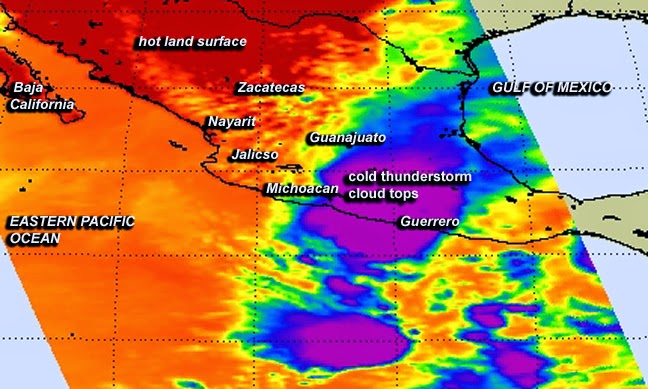
As the dissipating tropical low pressure system known as System 90E continued rain on Guerrero State in southern Mexico, the U.S. Geological Survey reported a 6.4 magnitude earthquake occurred there on Thursday, May 8 around noon local time (1 p.m. EDT). NASA’s Aqua satellite captured an infrared image of the low pressure area just three hours after the earthquake.
As showers fell on Guerrero State, USGS noted that the quake’s center was 9.3 miles (5 km) north of Tecpan de Galeana, Mexico. That’s about 60 miles (96.5 km) northwest of Acapulco and 172 miles (276.8 km) southwest of Mexico City. According to USGS, back on April 18, an 7.2 earthquake occurred just 40 miles from yesterday’s epicenter.
A false-colored infrared image from NASA’s Atmospheric Infrared Sounder (AIRS) instrument showed high, cold cloud tops associated with the thunderstorms in System 90E moving over southern Mexico on May 8 at 20:11 UTC/4:11 p.m. EDT. Some of the cloud tops were near -63 F (-52C) indicating some potential for heavy rainfall.
On May 9, the National Hurricane Center (NHC) noted that showers and thunderstorms associated with System 90E continued to become less organized during the early morning hours. The low pressure area is large and centered about 150 miles (241.4 km) southwest of Zihuatenejo, Guerrero State, Mexico.
The NHC discussion on May 9 noted that the upper-level winds have become unfavorable for development and this system, so System 90E now has a very low chance, near 0 percent of becoming a tropical cyclone during the next 48 hours or over the next five days for that matter- which is good news for southwestern Mexico.
Despite not having the potential to develop, however, System 90E is expected to continue to produce locally heavy rainfall and gusty winds over portions of southwestern Mexico during the next day or so, according to NHC. The Mexican Weather Service noted that System 90E has the potential to bring torrential rainfall to Michoacán and Guerrero states totaling between 5.9 to 9.8 inches (150 to 250 mm). These rains could produce life-threatening flash floods and mud slides.
Video :










